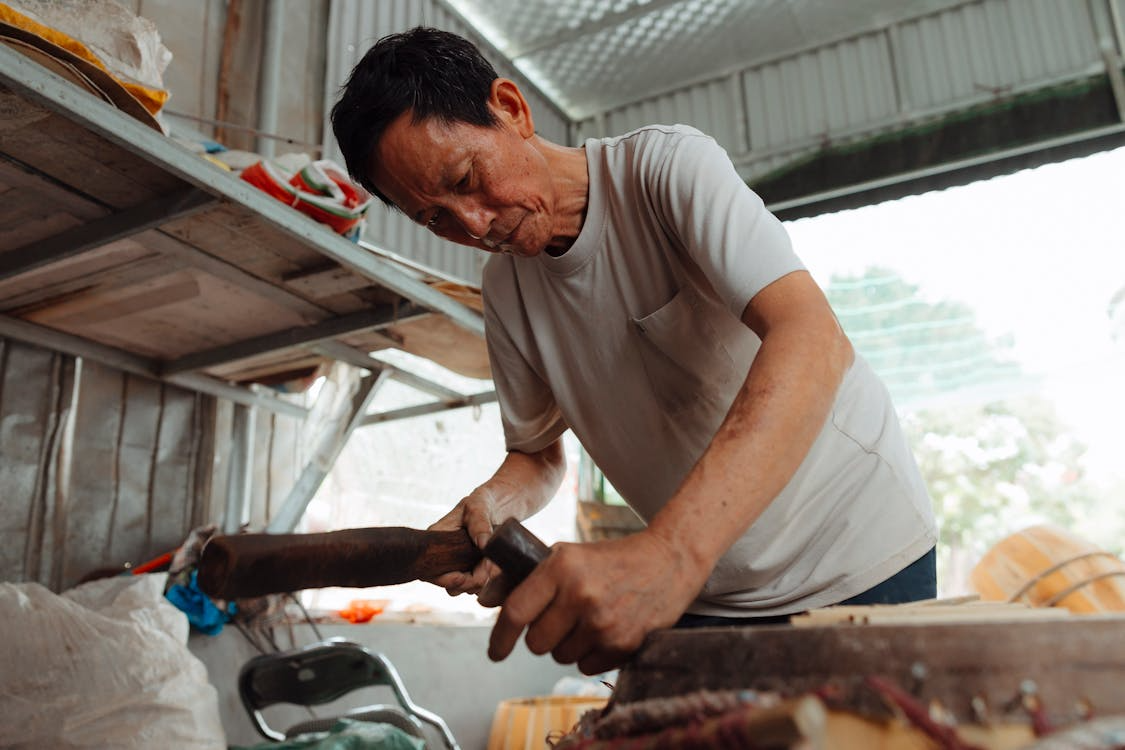
Paul Quealy’s knees had carried him through decades of carpentry and labouring, but by 60 they had begun to fail him. Each morning, his weathered hands reminded him of the years of heavy lifting, long hours, and relentless physical strain. The thought of working another seven years until pension age felt almost impossible.
For Paul, and thousands like him, Australia’s pension age of 67 represented more than just a number—it marked the distance between survival and despair. In July 2023, the pension age officially rose to 67, the culmination of changes that began in 2017. While designed to strengthen the long-term sustainability of Australia’s retirement system, the increase had left many older workers unable to keep up with policy expectations.
In this article
The Burden of Physical Work After 55
Paul’s story mirrored that of countless manual workers across regional and urban Australia. His recent surgery for skin cancer had required a graft, leaving him unable to complete full weeks of labour. Decades of carrying timber, bending, climbing, and lifting had worn the cartilage from his knees and shoulders, leaving him with daily pain.
His advice to younger tradesmen was simple but heavy with lived truth: ‘Save as much as you possibly can before you get to the age of 55 because it’s a long way to the pension and it can be a lot of pain as well.’
The hardship went beyond physical pain. Paul said he had felt the sting of rejection once he passed 55, describing how job opportunities seemed to vanish. ‘You hit 55 and you feel like nobody wants you anymore. I think it has a mental impact on you,’ he reflected.
This was not just perception. Research had shown that age discrimination remained a significant barrier for older workers, particularly in physically demanding fields where employers preferred younger recruits.
‘For some, 67 is an achievable and even desirable pension age. For others, the road there is far more demanding.’
When Retraining Failed to Help
The difficulties were not limited to traditional trades. For some, even after retraining, the barriers remained.
At 58, Peita McClenaghan had once run a school tuck shop, a role that required constant lifting, bending, and being on her feet. Years of this had left her with hip and shoulder degeneration. Hoping to find an alternative, she retrained in business administration.
But despite her efforts, she was unable to secure work. ‘I just felt I was being passed over,’ she said, describing the repeated rejection she suspected was tied to her age.
Now she lived on JobSeeker payments, with her rent consuming 80 per cent of her Centrelink allowance. ‘I say to people, “I am one rent increase away from homelessness” and I know that sounds very drastic but I literally am.’
The situation had become so dire that she had begun considering retiring overseas, somewhere she could survive on less—Vietnam, Thailand, Albania, anywhere that offered shelter at a fraction of the cost of Australian housing.
Global Comparisons
Australia’s pension age of 67 was not extraordinary by international standards. Iceland, Israel, and Norway had also set their pension age at 67. Many European nations still allowed retirement at 65 but planned to raise the threshold to 67 by 2030.
Some countries, however, had recognised the unique strain of physically demanding work. Finland, for example, allowed workers in arduous roles to retire at 63 without penalty. Several European nations had also established occupation-specific provisions for early retirement.
The OECD had studied these arrangements, describing them as rooted in fairness. Work that was hazardous or arduous shortened life expectancy and increased health risks, making it unreasonable to demand the same retirement age as those in less physically taxing jobs.
Australia’s Pension System Performance
Australia ranked 5th-6th globally for pension systems
Received a B+ grade from the Mercer CFA Institute Global Pension Index
Sustainability pressures loomed as the population aged
The Numbers Behind Retirement
For many, the reality was financial as much as physical. Professor Gary Martin explained that while some Australians could manage to work until 67, others faced impossible circumstances.
Manual workers forced into early retirement in their 50s often had superannuation balances between $200,000 and $350,000, with some having significantly less. This meant they either lived on drastically reduced incomes or drew down their savings early, leaving themselves worse off later.
Currently, about 63 per cent of Australians over 67 relied on the Age Pension, with 39 per cent receiving the full rate and 24 per cent receiving a partial pension. Despite decades of compulsory superannuation, the Age Pension remained the backbone of retirement for most Australians.
Even with recent increases in pension rates from September 2025—$29.70 per fortnight for singles and $44.80 combined for couples—many struggled under cost-of-living pressures.
Did you know?
Did you know? While Australia’s pension system ranked highly on the global stage, it offered one of the lowest replacement rates in the developed world, with retirees receiving about 40-50 per cent of their pre-retirement income from the Age Pension alone.
Seeking Solutions
Professor Martin argued that flexibility was essential. ‘Such flexibility could include staggered pension ages, occupation-specific provisions or partial pensions for those unable to continue to work full time,’ he suggested.
Paul Quealy also called for practical reforms, including financial assistance for manual labourers who required surgery, particularly when wait times in public hospitals prevented them from working. ‘So you can get back to work and support your family,’ he explained.
He also believed in some form of means-tested support for medical bills, recognising that manual workers were more likely to face health complications later in life.
Age discrimination was another obstacle requiring systemic attention. ‘Age bias can quietly edge out older workers from opportunities, with skills and experience too often overlooked in favour of younger recruits,’ Professor Martin said.
Lessons from Abroad
International models provided examples of how flexibility could be achieved. Some European systems reduced retirement age by one or two years for every five years worked in arduous roles, with a maximum reduction of up to ten years.
These policies reflected a simple principle—that not all careers placed equal demands on the body, and that policy should reflect these realities rather than applying a universal standard.
The Government’s Stance
Despite mounting debate, the federal government maintained a firm position. A Department of Social Services spokesperson said that pension eligibility was ‘set consistently across the community’ and was ‘not linked to a person’s past employment type, occupational history, or other social determinants, and the government has no plans to change this.’
The spokesperson added that ‘the social security system is designed to support those who need it most, while also ensuring it can be sustained for future generations.’
This stance reflected fiscal caution. Policymakers feared that making allowances for specific occupations could complicate administration and threaten long-term sustainability.
The Health Factor
Beyond financial strain, health outcomes shaped the retirement debate. Professor Martin noted that some retirees would enjoy decades of good health while others would spend much of retirement managing chronic illness or disability.
‘The financial cost of retiring early must be addressed, but the possibility of a shorter life expectancy due to years of physical work or its impact on an enjoyable retirement should also be considered,’ he said.
This complicated the argument that working longer automatically equated to more productive years. For many manual workers, it meant years of pain before they could access support.
What This Means for Manual Workers
- Current system required everyone to wait until 67 regardless of physical demands of their work
- International examples showed flexible approaches were possible
- Early retirement often led to financial hardship due to limited superannuation
- Age discrimination made career changes difficult after 55
- Government had no plans to introduce occupation-specific provisions
Looking Ahead
For workers like Paul and Peita, the system offered little immediate comfort. They faced years of scraping by on inadequate JobSeeker payments, diminishing superannuation, and the distant promise of the Age Pension.
The broader question remained—how could Australia adapt its retirement system to reflect both longer lifespans and the reality that not all workers aged the same way?
While no easy solutions existed, the growing call for flexibility suggested the debate was far from over.
For now, Paul’s advice to younger tradesmen remained the most sobering takeaway: start saving early, because the system expected your body to endure until 67—whether it could or not.
What This Means For You
Many manual workers found themselves physically unable to continue until the pension age of 67, yet had no early retirement option available to ease the burden. In contrast, other nations had recognised the toll of arduous jobs and introduced flexible systems, but Australia had not followed this path.
On top of this, age discrimination often shut older workers out of opportunities, even when they retrained in new fields. Government policy, meanwhile, remained focused on long-term fiscal sustainability rather than tailoring provisions to specific occupations.
For Australians approaching retirement, this meant that the rules did not always reflect the reality of ageing bodies, demanding jobs, and shrinking opportunities. It was a stark reminder that while policy aimed to protect the system, the human cost was still being carried by those least able to bear it.
This discussion about the struggles of working until 67 highlights just how heavy the burden can be when policies don’t reflect real-world limitations.
To see how others have reacted to these changes, it helps to look at another story where voices from the community were brought forward.
Their experiences paint an even clearer picture of the frustration and sense of unfairness that many feel about the rising pension age.
Read more: ‘Ludicrous and unfair’: Older workers speak out on retirement age changes
Australia’s Age Pension at 67 in 2025: No Change to 65 – Here’s How to Qualify—ED NEWS — Explains that the eligibility age has been 67 since July 2023 due to longer lifespans and rising retirement costs.
https://edstandards.com.au/australias-age-pension-at-67-in-2025/
Retirement age trends around the globe | World Economic Forum — Notes that Iceland, Israel, and Norway currently have the highest retirement age at 67 years, though actual retirement often occurs earlier.
https://www.weforum.org/stories/2023/10/retirement-age-trends-around-globe/
Retirement age worldwide by country| Statista — Reports that Israel, Iceland, and Norway had the highest retirement ages worldwide at 67 years among 45 countries surveyed.
https://www.statista.com/statistics/268824/retirement-age-in-international-comparison/
Retirement age—Wikipedia — States that many EU countries currently have a retirement age of 65, with increases to 67 expected across most nations by 2030.
https://en.wikipedia.org/wiki/Retirement_age
Pensions at a Glance 2017 OECD and G20 indicators — Highlights that Finland allows early retirement at 63 for those in arduous jobs without actuarial adjustment.
https://www.oecd.org/content/dam/oe...ance-2017_g1g8720d/pension_glance-2017-en.pdf
Should Pension Systems Recognise "Hazardous and Arduous Work"? — OECD research shows that special provisions for hazardous and arduous jobs have long existed to account for reduced life expectancy in such occupations.
https://ideas.repec.org/p/oec/elsaab/91-en.html
Will the Australian Age Pension Stop? Here’s What Could Change — Explains that Australia ranks 5th–6th globally for pension systems, consistently earning a B+ grade from the Mercer CFA Institute Global Pension Index.
https://www.equipsuper.com.au/about-us/news-and-updates/will-the-australian-age-pension-stop
Age Pension rates (September 2025 to March 2026) — Reports that about 63% of people over 67 receive either the full or partial Age Pension.
https://www.superguide.com.au/in-retirement/age-pension-rates
Age Pension rates (September 2025 to March 2026) — Notes that from September 2025, the maximum full Age Pension increased by $29.70 per fortnight for singles and $44.80 combined for couples.
https://www.superguide.com.au/in-retirement/age-pension-rates
Pensions at a Glance 2023 Country Profiles — Shows that in some systems, retirement age is reduced by one to two years for every five years of arduous work, with a maximum reduction of ten years.
https://www.oecd.org/content/dam/oe...ce-2023_4757bf20/PaG2023-country-profiles.pdf
Have you or someone you know faced the struggle of ageing in a physically demanding job while being too young for the pension?







